Pheidole williamsi
| Pheidole williamsi | |
|---|---|

| |
| Scientific classification | |
| Kingdom: | Animalia |
| Phylum: | Arthropoda |
| Class: | Insecta |
| Order: | Hymenoptera |
| Family: | Formicidae |
| Subfamily: | Myrmicinae |
| Tribe: | Attini |
| Genus: | Pheidole |
| Species: | P. williamsi |
| Binomial name | |
| Pheidole williamsi Wheeler, W.M., 1919 | |
| Synonyms | |
| |
Males were collected with the lectotype series in November 1905. (Wilson 2003)
Identification
See the description in the nomenclature section.
Keys including this Species
Distribution
Only known from the Known only from Isla Santa Cruz, Isla Seymour, and Isla San Salvador. An apparent endemic of the Galápagos Islands. The species appears to be rare. (Wilson 2003)
Distribution based on Regional Taxon Lists
Neotropical Region: Ecuador, Galapagos Islands (type locality).
Distribution based on AntMaps
Distribution based on AntWeb specimens
Check data from AntWeb
Countries Occupied
| Number of countries occupied by this species based on AntWiki Regional Taxon Lists. In general, fewer countries occupied indicates a narrower range, while more countries indicates a more widespread species. |

|
Estimated Abundance
| Relative abundance based on number of AntMaps records per species (this species within the purple bar). Fewer records (to the left) indicates a less abundant/encountered species while more records (to the right) indicates more abundant/encountered species. |

|
Biology
Association with Other Organisms
 Explore: Show all Associate data or Search these data. See also a list of all data tables or learn how data is managed.
Explore: Show all Associate data or Search these data. See also a list of all data tables or learn how data is managed.
Fungi
This species is a host for the fungus Myrmicinosporidium durum (a pathogen) in Galapagos Islands (Espadaler, 1997).
Castes
Worker
Minor
  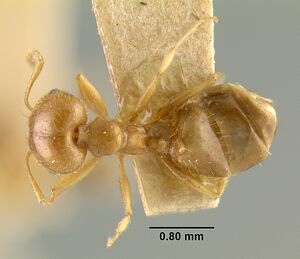   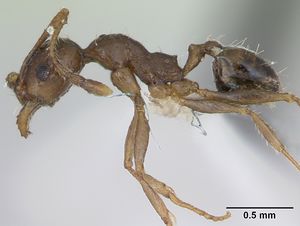  
| |
| . | |
Major
    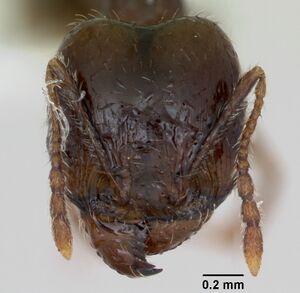   
| |
| . | |
Queen
Images from AntWeb
   
| |
| Queen (alate/dealate). Specimen code casent0173264. Photographer April Nobile, uploaded by California Academy of Sciences. | Owned by CDRS, Galapagos, Ecuador. |
   
| |
| Syntype of Pheidole williamsi. Queen (alate/dealate). Specimen code castype00444-03. Photographer April Nobile, uploaded by California Academy of Sciences. | Owned by CAS, San Francisco, CA, USA. |
Male
Images from AntWeb
  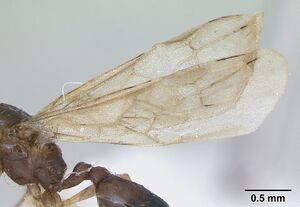  
| |
| Worker (major/soldier). Specimen code casent0173265. Photographer April Nobile, uploaded by California Academy of Sciences. | Owned by CDRS, Galapagos, Ecuador. |
  
| |
| Syntype of Pheidole williamsi. Male (alate). Specimen code castype00444-01. Photographer April Nobile, uploaded by California Academy of Sciences. | Owned by CAS, San Francisco, CA, USA. |
  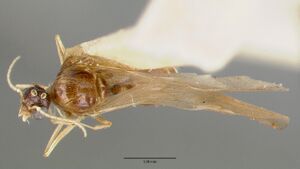 
| |
| Syntype of Pheidole williamsi. Male (alate). Specimen code castype00444-02. Photographer April Nobile, uploaded by California Academy of Sciences. | Owned by CAS, San Francisco, CA, USA. |
Nomenclature
The following information is derived from Barry Bolton's Online Catalogue of the Ants of the World.
- williamsi. Pheidole williamsi Wheeler, W.M. 1919c: 267 (s.w.q.m.) ECUADOR (Galapagos Is). Senior synonym of seymourensis: Wilson, 2003: 249.
- seymourensis. Pheidole williamsi var. seymourensis Wheeler, W.M. 1924a: 108 (s.w.) ECUADOR (Galapagos Is). Junior synonym of williamsi: Wilson, 2003: 249.
Unless otherwise noted the text for the remainder of this section is reported from the publication that includes the original description.
Description
From Wilson (2003): A small, yellow member of the diligens group, closest to Pheidole crozieri of Peru, but also with some similarities to Pheidole vafella, as well as Pheidole rufipilis and the mostly South American species listed with rufipilis (q.v.), differing from crozieri as follows.
Major: dark yellow; pronotum in side view peaked in a blunt angular profile, and weakly bilobous in dorsal-oblique view; occiput weakly concave; anterior margin of pronotal dorsum carinulate; apex of petiolar node in side view tapering to a blunt point.
Minor: petiolar node in side view relatively low, and in rear view with dorsal border strongly convex.
MEASUREMENTS (mm) Lectotype major: HW 1.04, HL 1.10, SL 0.74, EL 0.16, PW 0.52. Paralectotype minor: HW 0.48 (approximately), HL 0.62, SL 0.66, EL 0.12, PW 0.30.
COLOR Major: concolorous dark yellow.
Minor: body brownish yellow, appendages dark to medium yellow.
The Wheeler types may be faded; minors collected on Isla San Salvador in 1991 (P. Oromi) have light brown bodies.
Figure. Upper: lectotype, major. Lower: paralectotype, minor. Scale bars = 1 mm.
Type Material
GALÁPAGOS ISLANDS: Isla Santa Cruz. Museum of Comparative Zoology - as reported in Wilson (2003)
Etymology
Named after Harrison Williams, leader of a Galápagos collecting expedition. (Wilson 2003)
References
- Espadaler, X. 1997. Pheidole williamsi (Hymenoptera: Formicidae) parasitized by Myrmicinosporidium durum (Fungi) on San Salvador Island (Galapagos Islands). Sociobiology 30: 99-102.
- Herrera, H.W., Baert, L., Dekoninck, W., Causton, C.E., Sevilla, C.R., Pozo, P., Hendrickx, F. 2020. Distribution and habitat preferences of Galápagos ants (Hymenoptera: Formicidae). Belgian Journal of Entomology, 93: 1–60.
- Hosoishi, S., Rahman, M.M., Ogata, K. 2020. First record of Myrmicinosporidium durum (Fungi) parasitizing Pheidole nodus and P. indica (Hymenoptera: Formicidae) from Japan. Japanese Journal of Systematic Entomology, 26 (1): 40–42.
- Wheeler, W. M. 1919d. Expedition of the California Academy of Sciences to the Galapagos Islands, 1905-1906. XIV. The ants of the Galapagos Islands. Proc. Calif. Acad. Sci. (4)2(2 2: 259-297 (page 267, soldier, worker, queen, male described)
- Wilson, E. O. 2003. Pheidole in the New World: A dominant, hyperdiverse ant genus. Harvard University Press, Cambridge, MA. (page 249, fig. major, minor described, Senior synonym of seymourensis)
References based on Global Ant Biodiversity Informatics
- Clark, David B., Concepcion Guayasamin, Olga Pazmino, Cecilia Donoso, Yolanda Paez de Villacis. 1982. The Tramp Ant Wasmannia auropunctata. Biotropica. 14 (3):196-207.
- Herrera H. W. 2013. CDF Checklist of Galapagos Ants - FCD Lista de especies de Hormigas Galápagos. In: Bungartz, F., Herrera, H., Jaramillo, P., Tirado, N., Jiménez-Uzcátegui, G., Ruiz, D., Guézou, A. & Ziemmeck, F. (eds.). Charles Darwin Foundation Galapagos Species Checklist - Lista de Especies de Galápagos de la Fundación Charles Darwin. Charles Darwin Foundation / Fundación Charles Darwin, Puerto Ayora, Galapagos: http://checklists.datazone.darwinfoundation.org/terrestrial-invertebrates/formicidae/ Last updated: 01 Mar 2013
- Herrera H.W., and L. Roque-Albelo. 2007. Lista anotada de las hormigas de las Islas Galapagos, Ecuador. Fundación Charles Darwin. 13 pp
- Kempf, W.W. 1972. Catalago abreviado das formigas da regiao Neotropical (Hym. Formicidae) Studia Entomologica 15(1-4).
- Kusnezov N. 1963. Zoogeografia de las hormigas en sudamerica. Acta Zoologica Lilloana 19: 25-189
- Kusnezov N. 1963. Zoogeografia de las hormigas en sudamerica. Acta Zoologica Lilloana 19: 25-190
- Linsley E. G., and R. L. Usinger. 1966. Insects of the Galápagos Islands. Proc. Calif. Acad. Sci. (4) 33: 113-196.



